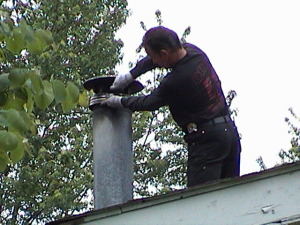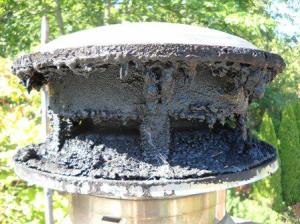Wood stove, remedy creosote problems
Wood stove, remedy creosote problems
by Paul Stevens
 Resolving creosote and other safety considerations in wood burning stoves and fireplaces.
Resolving creosote and other safety considerations in wood burning stoves and fireplaces.
If your wood stove chimney is creating a serious creosote problem, you are probably encountering cold air hitting the outside of the chimney and cooling the gases down too quickly before they escape into the air. This can happen on single metal pipe chimneys or where an extension has been added to a masonry chimney.
I encountered this problem with an outdoor wood furnace, despite being on an acreage our rather close neighbor would call and tell us we were smoking them out. My initial solution was to add 8′ foot of metal pipe to extend the chimney on up. This did improve the smoke situation but soon I began to notice creosote dripping out from the clean out at the base of the chimney. Because the stove was contained outside I wasn’t as concerned about a chimney fire as I would if it was in the house, but still concerned that I could have a roman candle going off if the creosote ignited sparking leaves and dry grass from catching on fire or worse my garage roof. I took the creosote issue very serious and began to research the problem.
I tried different mixes of seasoned woods, tried to burn it off with a hot fire of newspapers in the mornings before it built up, but nothing seemed to help the problem. Luckily I had access to a national fire safety expert that quickly clued me into the idea that the hot gases were being cooled too rapidly and liquefying before they could escape the top of the chimney extension.
 I found my solution by utilizing an 8” metal pipe to surround my 6” chimney pipe extension. I used the seamless commercial furnace duct pipe, instead of the snap joint pipe sold in the hardware and home centers. I was able to purchase a 8’ section so I had no joints to worry about. I wrapped the 6” chimney pipe with fiber glass insulation, the type you buy to wrap pipes without any backing. Fiber glass insulation without the paper backing will not burn or melt. Other insulation such as rock wool or ceramic insulation is commonly used in insulating chimneys. I then slid the 8” pipe over the top, and fabricated a welded metal cap that sealed the top to the 8” pipe and prevented any rain water from running down into the insulation. (Wet insulation will only conduct the heat, and not insulate, just like taken a hot pan out of the oven with a wet hot pad) If you don’t have welding and fabrication talent or equipment a welding shop can make a cap for you. It is a simple sleeve that slips over the top of the 8” pipe and has a sealed ring reducer that fits over and down into the top of the 6” chimney pipe to seal off the top and prevent rain water from entering. I was amazed at how this very thin layer of insulation surprisingly fixed my creosote problem.
I found my solution by utilizing an 8” metal pipe to surround my 6” chimney pipe extension. I used the seamless commercial furnace duct pipe, instead of the snap joint pipe sold in the hardware and home centers. I was able to purchase a 8’ section so I had no joints to worry about. I wrapped the 6” chimney pipe with fiber glass insulation, the type you buy to wrap pipes without any backing. Fiber glass insulation without the paper backing will not burn or melt. Other insulation such as rock wool or ceramic insulation is commonly used in insulating chimneys. I then slid the 8” pipe over the top, and fabricated a welded metal cap that sealed the top to the 8” pipe and prevented any rain water from running down into the insulation. (Wet insulation will only conduct the heat, and not insulate, just like taken a hot pan out of the oven with a wet hot pad) If you don’t have welding and fabrication talent or equipment a welding shop can make a cap for you. It is a simple sleeve that slips over the top of the 8” pipe and has a sealed ring reducer that fits over and down into the top of the 6” chimney pipe to seal off the top and prevent rain water from entering. I was amazed at how this very thin layer of insulation surprisingly fixed my creosote problem.
 Please Note: This was my solution, I’m not suggesting for anyone to run out and start messing with a chimney without some knowledge and experience, yours might be more complicated and a professional chimney expert may need to be consulted. Creosote build up is a disaster waiting to happen, a creosote fire is like a black smith forge fanned by rushing air up through the chimney. Knowing that cold air may be the culprit hopefully gives you a starting point, and may give those considering installing a wood stove some ideas. Creosote Cleaning Products
Please Note: This was my solution, I’m not suggesting for anyone to run out and start messing with a chimney without some knowledge and experience, yours might be more complicated and a professional chimney expert may need to be consulted. Creosote build up is a disaster waiting to happen, a creosote fire is like a black smith forge fanned by rushing air up through the chimney. Knowing that cold air may be the culprit hopefully gives you a starting point, and may give those considering installing a wood stove some ideas. Creosote Cleaning Products
Also Note: If you have a prefabricated triple wall chimney or a factory made collar to exit the wall or ceiling and roof never block the holes, alter the chimney cap, or fill in the gaps between the pipes. These pipes, collars and caps are designed to use convection cooling to make the outer edge safe to install at the manufactures space recommendations next to combustible materials. Always consult with the manufacture for the proper extensions or adapters to use with these chimneys. Blocking the air flow will create a fire hazard. A properly installed metal triple wall chimney should prevent the cold air from ever reaching the inner chimney to create a creosote problem.
Some of the ceiling collars have rather large holes and to the general person and even some installers, will assume these holes need to be covered with insulation to keep heat from escaping the room.
Even a zero clearance metal fireplace is designed to be used with triple wall chimneys made specifically for the fireplace. These fireplaces come with what appears to be a dryer vent that goes to the outside of the house. As the fireplace is being used convection air is pulled in from the vent around the inner chamber of the fireplace and then up around the chimney to keep the outer chamber of the fireplace and chimney pipe cool against combustible materials. It is a good idea to check the vent before each season to be sure it is not clogged with a bird or wasp nest, or with a snow drift during the season. So if you happen to come across a good deal on a zero clearance fireplace at a garage sale, please don’t run home and install it without the accompanying recommend triple wall chimney.
Have a safe and warm winter this season.
Article provided by A.P.N.


One Response
Hi,
I have creosote issues with my wood fired gasification boiler.
It is important is to be quite careful with moisture content of the wood fuel (15-20%).
Also be wary of dampening down to extend burn time. Boilers will run cooler when they are supplying energy to the water jacket and when the moisture is not being evaporated off it will form creosote on the boiler walls. This is not necesarily a problem if it is burned off when the boiler gets hot again in recovery mode.
It is also crucial to clean ash and creosote build up regularly.
If allowed to build up creosote forms an insulating layer and decreases boiler efficiency. A less efficient boiler will build up creosote more easily and quickly.
Creosote can also build up on the flue cap particularly in cold damp conditions. I don’t have bad creosote buildup in the flue only when the smoke combines with moisture as it exits the flue.
This would be a problem for anyone living in an area prone to cold and fog.
I have tried to find the best type of flue cap to cope with this issue to no avail.
Has anyone seen any solutions for this?
The treacly creosote that builds up on the chinese hat flue cap is not only unsightly but can pollute the rainwater tanks and corrode the flue and roof.